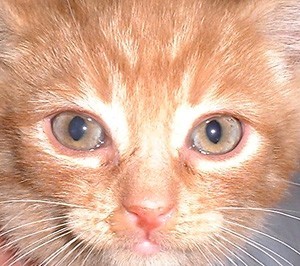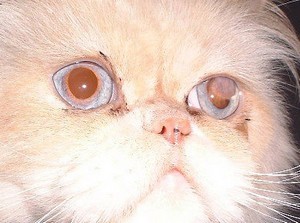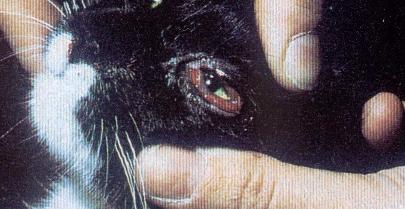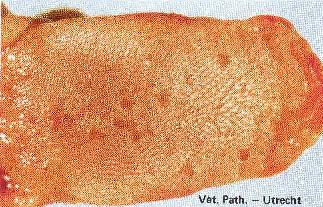BACKGROUND INFORMATION CAT FLU
What is Cat flu?
Cat Flu is a highly contagious (viral) infection in cats. It is quite common and can be very difficult to cure. Sneezing is a symptom of a beginning Cat Flu. The disease causes infection of the mucosa of the upper respiratory tract (nose, throat), the eyes and the mouth , causing the animal to sneeze and salivate. It resembles the flu and your cat can be seriously sick from it.
See photo: take special notice of the corners of the eyes and the nose.
 |
 |
Symptoms
Sneezing is the first obvious and audible sign of cat flu. There can be really heavy sneezing fits when a cat has cat flu. In catteries, where there are more cat flu patient you can hear continuous sneezing. During the first stages of cat flu, exercise and excitement seems to strengthen the urge to sneeze, thus spreading the virus more rapidly. The general condition of the cat and appetite can be normal during this stage. With increasing, watery and later on mucous nasal discharge and abundant salivation, the animals get more lethargic and a body temperature of 40 degrees Celsius can be measured. Even during the first stage of the disease there is not only infection of the mucosa of the nose ( a cold) and the mouth (salivating) , but also of the eyes. The membrane that lines the eye-ball and the back of the eye lids is moist, swollen and in a later stage, extremely red, see photo.
 |
From the second-third day onward the symptoms will change. The discharge becomes more mucous and even purulent, the nostrils are covered with crusts, the eyelids are closed and and crusted to the point that the cat has difficulty opening them. The poor patients will try to wash themselves, cleaning eyes and nostrils, but it is in vain. The discharge is smeared all over the skin around the mouth, the chest and paws .Especially in light coloured cats this is clearly visible. The peak of the disease is usually around third to fifth day . The patients breath through their mouths and often they refuse food and water. At this stage a cure is still possible, especially when the owner and vet are prepared and able to follow a consistent treatment. When the symptoms continue for3 weeks or more, the animals loose weight and get dehydrated.
A cat normally breathes trough its nose and, unlike dogs, is not able to breathe through its mouth without serious consequences. Forced to do so, the infection can spread to the trachea, bronchi and sometimes the lungs. As a result the cat starts to cough. The infected animals refuse food, not only because of their impaired breathing. Already with the first cat flu symptoms we notice saliva as a sign of a damaged mucous membrane of the mouth. This damage can be considerable, approximately in one in five cases the tongue, check- and lip membranes are coloured almost scarlet, and the formation of vesicles. The vesicles become blisters, the blisters rupture and cause
ulcerated wounds.
 |
Cat flu is no small thing. A complete cure tales 10 – 14 days, sometimes much longer. When the flu is neglected, coughing and infected sinuses can be a result and can last several months.
Infection
Cat flu is a disease that is caused by several germs. The most important ones are the Calici virus (FCV), the Herpes virus (FHV) and Chlamydia (bacteria). The symptoms they all cause are so alike, that we commonly refer to it as Cat Flu. Usually the infection is caused by multiple germs. Both viruses are caused by close and direct contact between cats. Infections caused by sneezing and coughing animals are less common. Although the nose- and throat mucus of acutely ill animals contains approximately as many viral agents as healthy appearing carriers, the first group is much more hazardous, because of the large quantity of discharge spread in the environment Therefore healthy cats are more easily infected by clinically ill animals than by healthy looking carriers. The outbreak of an epidemic in small spaces with many cats, like catteries, shelters, boarding kennels is definitely not impossible. The disease can possibly be transmitted through clothing, cages, baskets, our hands etc. Once infected with one of the viruses causing Cat Flu, a cat will often remain a carrier of the disease for the rest of its life. That means the cat shows no symptoms, but can infect other cats.
Characteristically, carriers of the Feline Herpes Virus secrete the herpes virus periodically. During such a period the carrier is highly contagious and a health hazard for vulnerable cats. Virus secretion can happen without any obvious cause, but it can also happen as a result of certain stress factors, like a visit to the vet, certain medications (especially corticosteroids), breeding, whelping and lactation, transport, shows. The virus secretion starts 4 to 11 days after the period of stress, lasts for about 7 days and is accompanied by mild symptoms. For a cat owner this means that he can recognize animals that regularly have Cat Flu. Because 80% of all cats infected with FHV become carriers, it is impossible to eliminate Cat Flu.
Percentage virus carriers
To estimate the percentage of virus carriers in a the feline population, throat smears were taken from show cats, solitary cats and cats that living in catteries. The smears were checked for the existence of herpes- (FHV) and calici (FCV) viruses. The table below shows that FCV is more often secreted than FHV.
| FCV | FHV | |
| (solitary) domestic cats | 8 % | 1 % |
| show (pedigree) cats | 24 % | 2 % |
| catteries | 41 % | 0,4 % |
It is an important fact that all the animals looked completely healthy and could have been sold. You do not need an overactive imagination to imagine what would happen when a virus carrying cat was brought into a virus free cattery.
Increasing immunity in kittens
Once infected with one of the viruses causing Cat Flu, a cat will often remain a carrier of the disease for the rest of its life. That means the cat shows no symptoms, but can infect other cats. A feline mother that is a virus carrier and shows no symptoms, can infect her kittens soon after birth. This can already cause Cat Flu at the age of 1 week, despite the antibodies the kittens have through their mother. When the mother is not a carrier and the kittens are well nursed they will get enough antibodies to protect them from infection with, among other things, Cat Flu . When the kittens are nursed well the first day, the protection against the herpes virus will last 4 to 8 weeks, against the calici virus 3 to 4 weeks.
Vaccinations against Feline Upper Respiratory Disease
There is a choice between a dead and living vaccine. For solitary cats the living vaccine is usually first choice. It usually provides longer protection against the virus, because the natural infection is mimicked. But there is also the small change that the cat will show symptoms of Cat Flu. The dead vaccine will be less effective, but will not cause any symptoms of Cat Flu. The disadvantage is the fact that multiple vaccinations are needed. Vaccinations cannot prevent your cat from at least becoming a carrier. Your cat will show no symptoms, but it can infect other cats. A cat that is a carrier prior to vaccination, will continue to infect other cats even after vaccination. You can discuss the best option for your cat with your vet.
Please note that the Cat Flu vaccine is not “updated” each year like the human Flu vaccine. Cat Flu is not contagious for humans.




